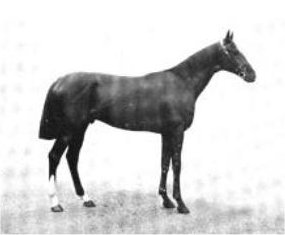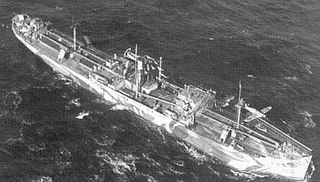
A landing ship, infantry (LSI) or infantry landing ship was one of a number of types of British Commonwealth vessels used to transport landing craft and troops engaged in amphibious warfare during the Second World War. LSIs were operated by the Royal Navy, British Merchant Navy, Royal Canadian Navy, Royal Indian Navy, and Royal Australian Navy. They transported British Commonwealth and other Allied troops in sea assaults and invasions throughout the war.

Empire Battleaxe was a British ship of the Second World War and as HMS Donovan in service with the Royal Navy just after the Second World War. Built as a Type C1-S-AY1 Landing Ship, Infantry named Cape Berkeley she then saw merchant service as Empire Battleaxe before being commissioned into the Royal Navy as HMS Empire Battleaxe and then Donovan. After she was decommissioned she returned to merchant service as Empire Battleaxe and was returned to the USA where she was renamed Cape Berkeley once again. A proposed sale in 1948 to China and renaming to Hai C fell through and she was scrapped in 1966.
HMS Sansovino was an infantry landing ship in service with the Royal Navy during the late stages of the Second World War.

Empire Baffin was a 6,978 ton cargo ship which was built by Lithgows Ltd, Port Glasgow in 1941 for the Ministry of War Transport (MoWT). She was commissioned in 1943 as HMS Sancroft, being converted into a cable laying ship for Operation Pluto. She was returned to the MoWT in 1946 and subsequently sold and renamed Clintonia. A final change of ownership in 1960 saw her renamed Aspis and she was scrapped in 1963.
SS Empire Bunting was a 6,318 GRT cargo ship which was built in 1919. She saw service between the wars under the US flag and was transferred to the UK Ministry of War Transport in the Second World War. She made a number of cross-Atlantic voyages, often sailing in convoys. She ended her career by being sunk as a blockship on the Normandy coast, supporting the allied landings there in 1944.
Empire Beaumont was a British 7,044 GRT cargo ship which was built by Furness Shipbuilding Ltd, Haverton Hill-on-Tees in 1942. She was owned by the Ministry of War Transport (MoWT) and managed by W Runciman & Co Ltd. Empire Beaumont had a short career, being sunk on 13 September 1942 while a member of Convoy PQ 18.
Empire Bede was a 6,959 GRT cargo ship which was built by G M Harland & Wolff Ltd, Glasgow in 1942 for the Ministry of War Transport (MoWT). She had a short career, being damaged by a torpedo and then sunk by gunfire on 18 August 1942.
Takliwa was a 7,936 GRT cargo liner that was built in 1924 by Barclay, Curle & Co Ltd, Glasgow, Scotland for the British India Steam Navigation Company. She was converted to a hospital ship during the Second World War, serving until she was wrecked in October 1945.

Sainfoin was a British Thoroughbred racehorse that was the winner of the 1890 Epsom Derby and was the sire of Rock Sand, the tenth winner of the Triple Crown in 1903.
HMS Empire Dace was a 716 GRT coastal ferry that was built in 1942 as a merchant ship by Swan, Hunter & Wigham Richardson Ltd Newcastle upon Tyne, United Kingdom for the Ministry of War Transport (MoWT). In 1943, she was requisitioned by the Royal Navy. She served until December 1944, when she struck a mine and sank in Greek waters.

Empire Darwin was a British 6,765 GRT CAM ship built in 1941 by William Gray & Co. Ltd., West Hartlepool, United Kingdom for the Ministry of War Transport (MoWT). Her Hawker Sea Hurricane was involved in the last action by an aircraft flown off a CAM ship, shooting down a Focke-Wulf Fw 200 Condor on 28 July 1943.
MV Empire Day was a 7,241 GRT cargo ship that was built in 1941 as a CAM ship by William Doxford & Sons Ltd, Sunderland, Co Durham, United Kingdom for the Ministry of War Transport (MoWT). In 1943, she was converted to a standard cargo ship. She served until August 1944 when she was torpedoed and sunk by U-198.
SS Empire Dell was a 7,065 GRT CAM ship that was built in 1941 by Lithgows Ltd, Port Glasgow, United Kingdom for the Ministry of War Transport (MoWT). She served until May 1942, when she was torpedoed and sunk by U-124 whilst a member of Convoy ONS 92.
Empire Dryden was a 7,164 GRT cargo ship that was built in 1941 by William Doxford & Sons Ltd, Sunderland, Co Durham, United Kingdom for the Ministry of War Transport (MoWT). Completed in February 1942, she had a short career, being torpedoed and sunk on 20 April 1942 by U-572.
Empire Eland was a 5,613 GRT Design 1019 cargo ship that was built in 1920 as West Kedron by Long Beach Shipbuilding Co, Long Beach, California, United States for the United States Shipping Board (USSB). She was transferred to the United States Maritime Commission (USMC) in 1937. In 1940, she was transferred to the Ministry of War Transport (MoWT). She was torpedoed and sunk by U-94 on the night of 15–16 September 1941.

Empire Energy was a 6,548 GRT cargo ship that was built in 1923 as Grete by Neptun AG, Rostock, Germany. She was sold to an Italian firm in 1932 and renamed Gabbiano. She was seized by the United Kingdom in 1940, passed to the Ministry of War Transport (MoWT) and renamed Empire Energy. She served until 5 November 1941, when she ran aground off Cape Norman, Newfoundland, and was wrecked.
MV Murell was a 319 GRT coaster that was built in 1940 as Fiddown by Goole Shipbuilding & Repairing Co Ltd, Goole, Yorkshire, United Kingdom for S Morris Ltd. In 1941, she was run down and sunk by HMS Campbelltown in the Mersey Estuary. She was salvaged in 1942, repaired and passed to the Ministry of War Transport (MoWT), renamed Empire Estuary. She was sold into merchant service in 1946 and renamed Goldfawn. A further sale in 1952 saw her renamed Creekdawn. A sale to an Irish company in 1954 saw her renamed Murell. She served until 1972, when she was scrapped.
Empire Eve was a 5,979 GRT CAM ship that was built in 1941 by William Pickersgill & Sons Ltd, Sunderland, Co Durham, United Kingdom for the Ministry of War Transport (MoWT). She served until 1943, when she was torpedoed and sunk by U-414 off Algeria.
Empire Explorer was a 5,985 GRT cargo ship that was built as the cargo liner Inanda in 1925 by Swan, Hunter & Wigham Richardson Ltd, Newcastle upon Tyne, Northumberland, United Kingdom for a British shipping line. She was hired by the Royal Navy in 1940 for use as an ocean boarding vessel but was sunk in an air raid London in September 1940. She was salvaged, rebuilt as a cargo ship, passed to the Ministry of War Transport (MoWT) and renamed Empire Explorer. She served until 9 July 1942, when she was torpedoed and sunk by U-575 in the West Indies.
Prins Harald was a 7,244 GRT cargo ship that was built as Empire Field in 1941 by William Doxford & Sons Ltd, Sunderland for the Ministry of War Transport (MoWT). She was transferred to the Norwegian Government in October 1942 and renamed Prins Harald. She was torpedoed and sunk on 20 November 1942 by U-263 with the loss of three of her crew.






